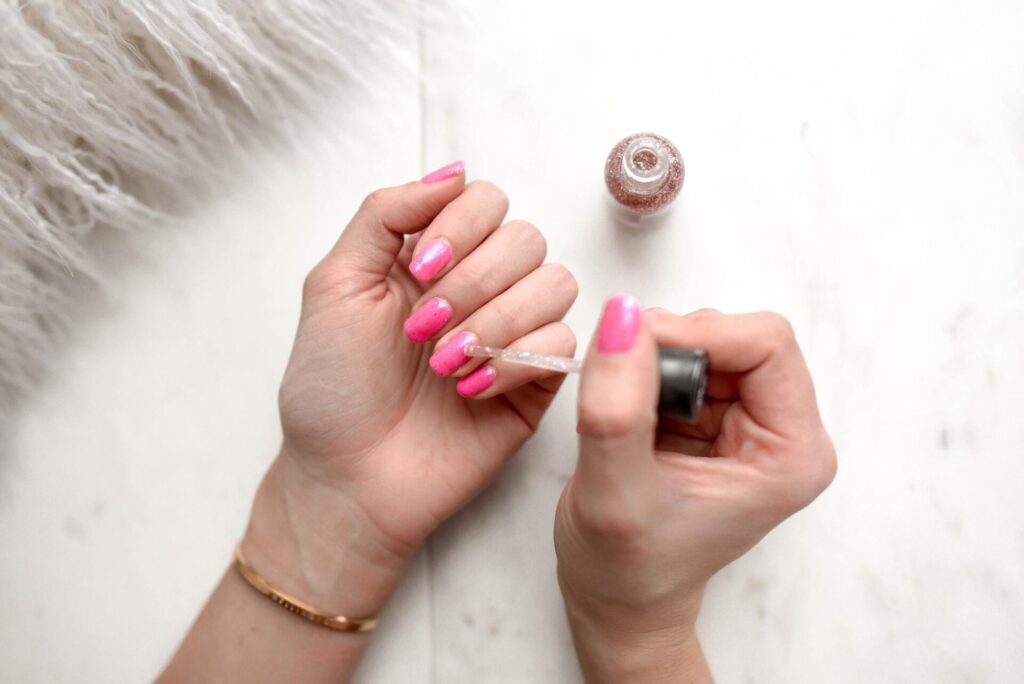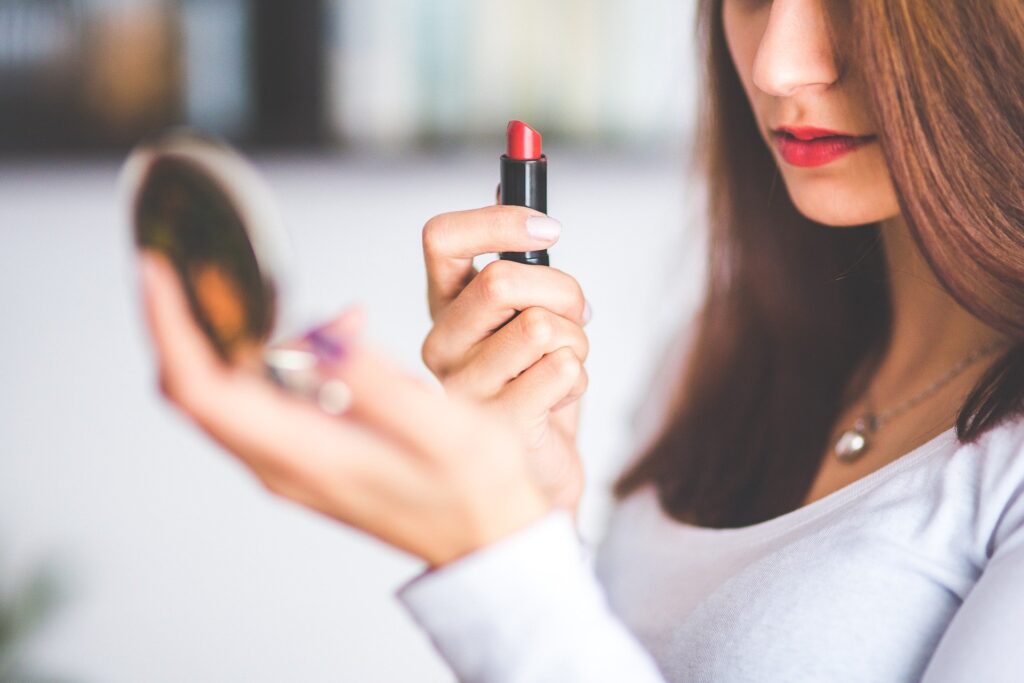Most of us love looking beautiful, but the disturbing truth is that most makeup is toxic for your skin and health. Learn which toxic ingredients to avoid when buying makeup, and skin care products.
There are at least 12 toxic chemicals in makeup that could be making us sick.
And that includes even expensive cosmetics! In order to keep your “look” the way you wanted it, it’s important to know what “makes” makeup. toxicoxic chemicals appear in makeup, skin care products, lotions, creams, sunscreens, shampoos and soaps.
But the biggest issue? These chemicals are not regulated by the government and the cosmetics industry pushes back against restrictions in a big way.

One truly disturbing fact: Of the thousands of chemicals used regularly in cosmetics, only a tiny fraction have been tested for human safety. Plus, cosmetics producers are also given a lot of leeway. Current regulations allow many chemicals to be “hidden” on product labels, under the category of “fragrance.” Fragrances are considered proprietary formulas, therefore, fragrance ingredients do not have to be listed separately on ingredient labels.
There are healthy alternatives to the toxic chemical-filled beauty products that you may be using. But, before we talk about how to find the right healthy-for-you makeup and cosmetics, you need to know which chemicals are in most cosmetics. They might be in the makeup that you’re already using. And you need to know what they are doing to your body. Then you’ll know which toxic makeup ingredients to avoid when you are shopping for makeup and skin care products.
Toxic Beauty Product Ingredients To Avoid
If you are not concerned yet, take a minute to read the list below for how these chemicals destroy skin and health:
1. Isobutyl and Isopropol Parabens

Normally used as preservatives, parabens are often found in eye makeup, sun screen. lotions and shampoos. They are known to disrupt hormones and damage the reproductive system, causing allergies and even breast cancer.
Avoid anything on product labels that contains the word “paraben” whether it be methylparaben, butylparaben, ethylparaben, propylparaben. No paraben is your friend!
2. Propolyne Glycols (PEGs)
PEGs are petroleum derivatives that are used in make-up, particularly in cream bases, to increase absorbency into the skin. Depending on production methods, PEGs are known hormone disruptors. They harm the nervous system and cause developmental issues.
3. Formaldehyde
Formaldehyde is a preservative in makeup and is known to cause cancer. Additionally, there are many chemicals that are not formaldehyde itself, but are known as “formaldehyde releasers.” That means they generate formaldehyde, which is then absorbed through the skin. Formaldehyde releasers slowly release formaldehyde, keeping a level of preservatives present in the product over time, to increase the product’s shelf life.

Although the amount of formaldehyde or formaldehyde releaser in any given cosmetic product may be small, it may be lurking in more than one of your regular products. And makeup is not the only source of formaldehyde in our lives. We are often exposed to formaldehyde in vehicle exhaust, pressed wood products, cigarette smoke, gas stoves and more. So, it’s worth cutting down our carcinogenic formaldehyde intake where we do have control in our lives.
Formaldehyde releasers can be found in nail polish, nail polish removers, eye makeup and soaps by these names:
- Quaternium 15
- Methylene glycol
- Paraformaldehyde
- Diazolidinyl Urea, among others
4. Sodium Laureth Sulfate and Sodium Lauryl Sulfate
Sulfates are some of the most common toxic chemicals to avoid in makeup and skin care products. Found in shampoos, body lotions, toothpaste and more, these chemicals act as foaming agents. Sulfates irritate the skin and have been associated with allergies. But the real danger is that the cosmetic production process can create a by-product known as nitrosamine.
Nitrosamine is a strong cancer-causing substance. It affects many organs, such as the pancreas, lungs, stomach, brain and liver. Dioxane, one of these bi-product contaminants, is know to cause liver and nasal cancers. Makeup and skin care companies are not required to test for nitrosamine presence in their products. Therefore, you’ll want to avoid products that contain the toxic Sodium Laureth or Sodium Lauryl Sulfate ingredients.
Sulfates are listed under the following names on cosmetic labels:
- Sodium Lauryl Sulfate
- Sodium Laureth Sulfate
- Ammonium Laureth Sulfate
- Ammonium Lauryl Sulfate
- Hydrolyzed Animal Protein
- Hydroxymethylsarcosine
- Imidazolidinyl Urea
- DEA
- MEA
- TEA
5. Phthalates
Among the most dangerous and toxic makeup ingredients, phthalates disrupt hormones and cause reproductive damage in both men and women. That means that if you’re smooching with a man, your makeup can actually lower his fertility rate and testosterone levels!

Phthalates are generally added to plastic to make it more flexible and long lasting. But they’re also used as moisturizers in makeup to encourage product ingredients to absorb into the skin. They don’t have to be listed on labels if they are “hidden” by cosmetic companies under the aforementioned “fragrance” umbrella. Though they’re not fragrances themselves, they are chemicals that also enhance the fragrances of perfumes.
Diethyl phthalate, or DEP is one of these chemicals to look for on product labels. Better yet, look for products that say” phthalates-free” on the label, as even “fragrance-free” products may include fragrance enhancing chemicals.
Phthalates can be found in scented lip balms, skin creams, deodorants, face and body paint, lotions, fragrances and more.
6. Talc
Talcum powder, or talc, is a magnesium silicate clay mineral that occurs naturally. It’s used in makeup, deodorizing powders, deodorant, and baby powders due to its smooth, chalky absorbent nature.
Talc has been the subject of controversy for many years, associated with both lung and respiratory diseases, plus lung and ovarian cancers.
Talc that is used in baby powders for infants is considered harmful, as its particles are minuscule and easily ingested when airborne, causing lung and respiratory problems.
People working in mines who are exposed to talc are at high risk for lung cancer.
Talc alone is questionable, but talc has historically been mined in areas that also mine asbestos, a known carcinogen. When contaminated with asbestos, talc has been associated with cancer, particularly when used by women in the genital area.
Although women have won lawsuits by proving that their use of talcum powder over many years caused their ovarian cancer, the government has yet to issue warnings about talc use and does not require asbestos testing of talc products.
7. Toluene
Toluene is a highly volatile and toxic petrochemical solvent that is particularly hazardous if its fumes are inhaled. It is found in household products such as paints, lacquer, adhesives and glue.
Unfortunately for most women, it is also used regularly in hair dyes and nail products. It can damage the immune system and can also cause birth defects – for this reason, pregnant women should always avoid using products such as nail polish or hair dyes that contain toluene.
Toluene exposure can also cause mild symptoms like fatigue, dizziness, nausea, headache and confusion, and more serious issues like liver and kidney damage.
8. Hydroquinone
Also known as tocopheryl acetate, this chemical is a carcinogen. It is also associated with toxicity of organs and irritation of the respiratory system.
Hydroquinone is most often found in skin lightening creams and in makeup foundation, so it’s a major toxic makeup ingredient to avoid.
9. Petrolatum
Petrolatum or mineral oil is a petrochemical derived from oil. It is used in many skin care products to seal moisture into the skin. While it is effective, petrolatum can dry out skin by not allowing it to breathe under the surface barrier. This, in turn, can clog pores and cause inflammation, providing an environment where yeast and fungus can thrive.
In the long standing debate about petrolatum, large companies claim that their products are highly refined and thus cause no risk. While highly refined petrolatum has not proven conclusively to be harmful to health, more often, producers use lesser refined petrolatum.
Less refined petrolatum does, indeed cause health problems. Studies also show that once petrolatum enters the body, it does not metabolize, therefore it never leaves the body!
Petrolatum can be found in body lotions, baby oil, sunscreens, lipsticks and more. It may be listed on labels as:
- Paraffin Oil
- Liquid Paraffin
- Mineral Oil
- Petrolatum
- Petroleum Jelly
10. Oxybenzone
Oxybenzone is most commonly found in chemical sunscreens and is extremely harmful to the endocrine system. This is important, because the endocrine system regulates metabolism, sleep patterns, stress levels and regulates all of our glands. If you suffer from PCOS, which is an endocrine disorder, it’s very important to avoid toxic chemicals such as oxybenzone.

Although oxybenzone’s purpose is to protect against harmful UV (ultra-violet) sun rays, repeated use causes skin allergies and photo-sensitivity. Chemical sunscreens are touted to prevent skin cancer, but there has been a steady rise in skin cancer incidence over the years. It is widely understood now that chemical sunscreens are one of the culprits.
Oxybenzone is found in not only sunscreens, but in makeup, lipsticks and balms and SPF body lotions.
Product label ingredients to avoid:
- Oxybenzone
- Octisalate
- Octocrylene
- Avobenzone
- Octinoxate
- Homosalate
11. Sodium Benzoate
Sodium benzoate is added to this list because it’s often used in skin care products to counter act mold and bacteria; in other words, as a preservative.
Sodium Benzoate alone is not so problematic. However, it often appears with Vitamin C (ascorbic acid). Vitamin C is used in skin care products because it’s very good for anti-aging. When sodium benzoate and Vitamin C come together, it causes a chemical reaction, producing yet another chemical called benzene. Because the resulting benzene is not an ingredient that the producers put in the product, they don’t have to list benzene as an ingredient on product labels.
However. benzene is bad for health. Long term exposure can result in headaches, allergies, nausea, rapid heart rate and even cancer.
So, sodium benzoate is also a toxic ingredient in beauty products to avoid.
12. Colorants
You should be aware of artificial chemical colorants that are not only in cosmetics but also in foods. Have you noticed that food colors are becoming more and more bright and unrealistic looking? Especially in those aimed at attracting children? Those are the same colorants that qualify as toxic chemicals in beauty products!

Some of them are known carcinogens, such as Red 3, and Red 40. Yellow 6 and others are still under study. Initial studies indicate that some yellow, blue and green dyes cause cancer and/or other serious health issues. But, as noted before, heavy pressure from the cosmetics industry slows down research and delays bans on dangerous substances.
Side note: Vegans, vegetarians, and those concerned about animal cruelty should be aware that some red colorants in cosmetics are sourced from insects. The terms cochineal, carmine and E120 indicate bright crimson colorants that come from grinding the dried bodies of the tiny cochineal bug into powder. So, if your lipstick is red, or your blush is rosy, look out for those two names on the ingredient label.
Additional Tip: Aluminum
Aluminum is an ingredient in deodorants, mostly antiperspirants. Aluminum in deodorant is associated with breast cancer and other cancers. When used regularly (as most deodorants and antiperspirants are) aluminum also causes higher risk of reproductive issues, and Alzheimer’s. The key here is use over time, so please consider using an organic and natural antiperspirant that does not contain aluminum. Luckily, there are many good quality and effective alternative choices available these days.
What You Can Do About All The Toxic Ingredients In Your Beauty Products

The evidence is overwhelming when it comes to toxic ingredients in beauty products. Not only are they bad for our personal health, but there are devastating effects of these chemicals for the earth as well.
We can, however, let our purchasing dollars speak to the cosmetics industry. We can choose to buy beauty products that don’t contain toxic chemicals. Think about how much makeup, skin cream, deodorant and lotion we wear daily.
Now calculate how much chemical absorbs into our skin from that makeup every day and has cumulative effects. Add to that the amount of makeup we ingest in the form of lipstick and lip gloss.
It’s worth it to avoid the offenders and choose something good for our skin and our overall health.
Sources:
- https://www.ewg.org/skindeep/
- https://www.consumerreports.org/health/food-additives/red-dye-3-banned-in-cosmetics
Disclaimer: This post is for informational purposes only. Any material herein is the expressed opinion of the authors and is not a substitute for professional advice, diagnosis or treatment, nor has it been evaluated by any regulatory agency. All use of information herein is solely at the risk and discretion of the reader. Have a blog? This post is for sale. Contact us.